French cuisine
This articleneeds additional citations forverification.(February 2023) |
| Part ofa serieson the |
| Culture of France |
|---|
| People |
| Mythologyandfolklore |
| Cuisine |
| Festivals |
| Religion |
| Musicandperforming arts |
| Sport |
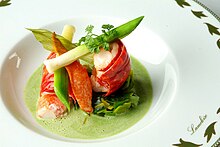
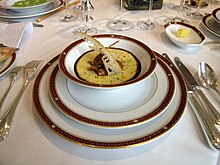
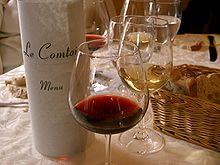
French cuisineis thecookingtraditions and practices fromFrance.In the 14th century,Guillaume Tirel,acourtchefknown as "Taillevent", wroteLe Viandier,one of the earliestrecipecollections ofmedieval France.In the 17th century, chefsFrançois Pierre La VarenneandMarie-Antoine Carêmespearheaded movements that shifted French cooking away from its foreign influences and developed France's own indigenous style.
Cheeseandwineare a major part of the cuisine. They play different roles regionally and nationally, with many variations andappellation d'origine contrôlée(AOC) (regulated appellation) laws.[1]
Culinary tourismand theGuide Michelinhelped to acquaint commoners with thecuisine bourgeoiseof the urban elites and the peasant cuisine of the French countryside starting in the 20th century. Many dishes that were once regional have proliferated in variations across the country.
Knowledge of French cooking has contributed significantly to Western cuisines. Its criteria are used widely in Western cookery school boards andculinary education.In November 2010, Frenchgastronomywas added by theUNESCOto its lists of the world's"intangible cultural heritage".[2][3]
History
[edit]Middle Ages
[edit]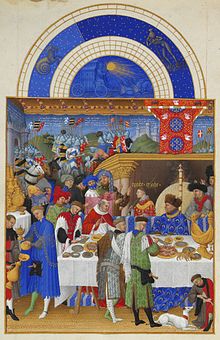
In Frenchmedieval cuisine,banquets were common among thearistocracy.Multiple courses would be prepared, but served in a style calledservice en confusion,or all at once. Food was generally eaten by hand, meats being sliced off in large pieces held between the thumb and two fingers. The sauces were highly seasoned and thick, and heavily flavored mustards were used.
Pies were a common banquet item, with the crust serving primarily as a container, rather than as food itself, and it was not until the very end of theLate Middle Agesthat theshortcrustpie was developed.
Meals often ended with anissue de table,which later changed into the modern dessert, and typically consisted ofdragées(in the Middle Ages, meaning spiced lumps of hardened sugar or honey), aged cheese, and spiced wine, such ashypocras.[4]: 1–7
The ingredients of the time varied greatly according to the seasons and the church calendar, and many items were preserved with salt, spices, honey, and other preservatives. Late spring, summer, and autumn afforded abundance, while winter meals were more sparse.Livestockwere slaughtered at the beginning of winter. Beef was often salted, while pork was salted and smoked. Bacon and sausages would be smoked in the chimney, while the tongue and hams werebrinedand dried. Cucumbers were brined as well, while greens would be packed in jars with salt. Fruits, nuts and root vegetables would be boiled in honey for preservation. Whale, dolphin and porpoise were considered fish, so duringLent,the salted meats of these sea mammals were eaten.[4]: 9–12
Artificial freshwater ponds (often calledstews) heldcarp,pike,tench,bream,eel,and other fish.Poultrywas kept in special yards, with pigeon andsquabbeing reserved for the elite. Game was highly prized, but very rare, and includedvenison,boar,hare,rabbit, andfowl.
Kitchen gardens provided herbs, including some, such astansy,rue,pennyroyal,andhyssop,which are rarely used today. Spices were treasured and very expensive at that time—they included pepper, cinnamon, cloves, nutmeg, andmace.Some spices used then, but no longer today in French cuisine arecubebs,long pepper (both from vines similar to black pepper),grains of paradise,andgalengale.
Sweet-sour flavors were commonly added to dishes with vinegar andverjuscombined with sugar (for the affluent) or honey. A common form of food preparation was to thoroughly cook, pound, and strain mixtures into fine pastes and mushes, something believed to be beneficial to make use of nutrients.[4]: 13–15
Visual display was prized. Brilliant colors were obtained by the addition of, for example, juices from spinach and the green part ofleeks.Yellow came fromsaffronor egg yolk, while red came fromsunflower,and purple came fromCrozophora tinctoriaorHeliotropium europaeum.
Gold andsilver leafwere placed on food surfaces and brushed with egg whites. Elaborate and showy dishes were the result, such astourte parmeriennewhich was a pastry dish made to look like a castle with chicken-drumstick turrets coated withgold leaf.One of the grandest showpieces of the time was a roastswanorpeacocksewn back into its skin with feathers intact, the feet and beak beinggilded.Since both birds are stringy, and taste unpleasant, the skin and feathers could be kept and filled with the cooked, minced and seasoned flesh of tastier birds, like goose or chicken.[4]: 15–16
The most well-known French chef of the Middle Ages wasGuillaume Tirel,also known as Taillevent. Taillevent worked in numerous royal kitchens during the 14th century. His first position was as a kitchen boy in 1326. He was chef toPhilip VI,then theDauphinwho was son ofJohn II.The Dauphin became KingCharles V of Francein 1364, with Taillevent as his chief cook. His career spanned sixty-six years, and upon his death, he was buried in grand style between his two wives. His tombstone represents him in armor, holding a shield with three cooking pots,marmites,on it.[4]: 18–21
Ancien Régime
[edit]Paris was the central hub of culture and economic activity, and as such, the most highly skilled culinary craftsmen were to be found there. Markets in Paris such asLes Halles,la Mégisserie,those found alongRue Mouffetard,and similar smaller versions in other cities were very important to the distribution of food. Those that gave French produce its characteristic identity were regulated by theguildsystem, which developed in theMiddle Ages.In Paris, the guilds were regulated by city government as well as by the French crown. A guild restricted those in a given branch of the culinary industry to operate only within that field.[4]: 71–72
There were two groups of guilds—first, those that supplied the raw materials: butchers, fishmongers, grain merchants, and gardeners. The second group were those that supplied prepared foods: bakers,pastry cooks,sauce makers, poulterers, andcaterers.Some guilds offered both raw materials and prepared food, such as thecharcutiersandrôtisseurs(purveyors of roasted meat dishes). They would supply cooked meat pies and dishes as well as raw meat and poultry. This caused issues with butchers and poulterers, who sold the same raw materials.[4]: 72–73
The guilds served as a training ground for those within the industry. The degrees of assistant cook, full-fledged cook and master chef were conferred. Those who reached the level of master chef were of considerable rank in their individual industry, and enjoyed a high level of income as well as economic and job security. At times, those in the royal kitchens did fall under theguildhierarchy, but it was necessary to find them a parallel appointment based on their skills after leaving the service of the royal kitchens. This was not uncommon as the Paris cooks' Guild regulations allowed for this movement.[4]: 73
During the 16th and 17th centuries, French cuisine assimilated many new food items from theNew World.Although they were slow to be adopted, records of banquets showCatherine de' Medici(1519–1589?) serving sixty-six turkeys at one dinner.[4]: 81 The dish calledcassoulethas its roots in the New World discovery ofharicot beans,which are central to the dish's creation, but had not existed outside of the Americas until the arrival of Europeans.[4]: 85
Haute cuisine(pronounced[otkɥizin],"high cuisine" ) has foundations during the 17th century with a chef namedLa Varenne.As an author of works such asLe Cuisinier françois,he is credited with publishing the first true French cookbook. His book includes the earliest known reference torouxusing pork fat. The book contained two sections, one for meat days, and one forfasting.His recipes marked a change from the style of cookery known in the Middle Ages to new techniques aimed at creating somewhat lighter dishes, and more modest presentations of pies as individual pastries and turnovers. La Varenne also published a book on pastry in 1667 entitledLe Parfait confitvrier(republished asLe Confiturier françois) which similarly updated and codified the emerginghaute cuisinestandards for desserts and pastries.[4]: 114–120
ChefFrançois MassialotwroteLe Cuisinier roïal et bourgeoisin 1691, during the reign ofLouis XIV.The book contains menus served to the royal courts in 1690. Massialot worked mostly as a freelance cook, and was not employed by any particular household. Massialot and many other royal cooks received special privileges by association with the French royalty. They were not subject to the regulation of the guilds; therefore, they could cater weddings and banquets without restriction. His book is the first to list recipes Alpha betically, perhaps a forerunner of the first culinary dictionary. It is in this book that amarinadeis first seen in print, with one type for poultry and feathered game, while a second is for fish and shellfish. No quantities are listed in the recipes, which suggests that Massialot was writing for trained cooks.[4]: 149–154
The successive updates ofLe Cuisinier roïal et bourgeoisinclude important refinements such as adding a glass of wine tofish stock.Definitions were also added to the 1703 edition. The 1712 edition, retitledLe Nouveau cuisinier royal et bourgeois,was increased to two volumes, and was written in a more elaborate style with extensive explanations of technique. Additional smaller preparations are included in this edition as well, leading to lighter preparations, and adding a third course to the meal.Ragout,a stew still central to French cookery, makes its first appearance as a single dish in this edition as well; prior to that, it was listed as a garnish.[4]: 155
Late 18th century – early 19th century
[edit]

Shortly before the French Revolution, dishes likebouchées à la Reinegained prominence. Essentially royal cuisine produced by the royal household, this is a chicken-based recipe served onvol-au-ventcreated under the influence of QueenMarie Leszczyńska,the Polish-born wife ofLouis XV.This recipe is still popular today, as are other recipes from Queen Marie Leszczyńska likeconsommé à la Reineandfilet d'aloyau braisé à la royale.Queen Marie is also credited with introducingPolonaise garnishingto the French diet.
TheFrench Revolutionwas integral to the expansion of French cuisine, because it abolished the guild system. This meant anyone could now produce and sell any culinary item they wished.
Bread was a significant food source among peasants and the working class in the late 18th century, with many of the nation's people being dependent on it. In French provinces, bread was often consumed three times a day by the people of France.[5]According to Brace, bread was referred to as the basic dietary item for the masses, and it was also used as a foundation for soup. In fact, bread was so important that harvest, interruption of commerce by wars, heavy flour exploration, and prices and supply were all watched and controlled by the French Government. Among the underprivileged, constant fear of famine was always prevalent. From 1725 to 1789, there were fourteen years of bad yields to blame for the low grain supply. In Bordeaux, during 1708–1789, thirty-three bad harvests occurred.[5]
Marie-Antoine Carêmewas born in 1784, five years before theRevolution.He spent his younger years working at apâtisserieuntil he was discovered byCharles Maurice de Talleyrand-Périgord;he would later cook forNapoleon Bonaparte.Prior to his employment with Talleyrand, Carême had become known for hispièces montées,which were extravagant constructions of pastry and sugar architecture.[6]: 144–145
More important to Carême's career was his contribution to the refinement of French cuisine. The basis for his style of cooking was his sauces, which he namedmother sauces.Often referred to asfonds,meaning "foundations", these base sauces,espagnole,velouté,andbéchamel,are still known today. Each of these sauces was made in large quantities in his kitchen, then formed the basis of multiple derivatives. Carême had over one hundred sauces in his repertoire.
In his writings, soufflés appear for the first time. Although many of his preparations today seem extravagant, he simplified and codified an even more complex cuisine that existed beforehand. Central to his codification of the cuisine wereLe Maître d'hôtel français(1822),Le Cuisinier parisien(1828) andL'Art de la cuisine française au dix-neuvième siècle(1833–5).[6]: 144–148
Late 19th century – early 20th century
[edit]
Georges Auguste Escoffieris commonly acknowledged as the central figure to the modernization ofhaute cuisineand organizing what would become the national cuisine of France. His influence began with the rise of some of the great hotels in Europe and America during the 1880s-1890s. TheSavoy Hotelmanaged byCésar Ritzwas an early hotel in which Escoffier worked, but much of his influence came during his management of the kitchens in the Carlton from 1898 until 1921. He created a system of "parties" called thebrigade system,which separated the professional kitchen into five separate stations.
These five stations included thegarde mangerthat prepared cold dishes; theentremettierprepared starches and vegetables, therôtisseurprepared roasts, grilled and fried dishes; thesaucierprepared sauces and soups; and thepâtissierprepared all pastry and desserts items.
This system meant that instead of one person preparing a dish on one's own, now multiple cooks would prepare the different components for the dish. An example used isoeufs au plat Meyerbeer,the prior system would take up to fifteen minutes to prepare the dish, while in the new system, the eggs would be prepared by theentremettier,kidney grilled by therôtisseur,truffle sauce made by thesaucierand thus the dish could be prepared in a shorter time and served quickly in the popular restaurants.[6]: 157–159
Escoffier also simplified and organized the modern menu and structure of the meal. He published a series of articles in professional journals which outlined the sequence, and he finally published hisLivre des menusin 1912. This type of service embraced theservice à la russe(serving meals in separate courses on individual plates), which Félix Urbain Dubois had made popular in the 1860s. Escoffier's largest contribution was the publication ofLe Guide Culinairein 1903, which established the fundamentals of French cookery. The book was a collaboration with Philéas Gilbert, E. Fetu, A. Suzanne, B. Reboul, Ch. Dietrich, A. Caillat and others. The significance of this is to illustrate the universal acceptance by multiple high-profile chefs to this new style of cooking.[6]: 159–160
Le Guide Culinairedeemphasized the use of heavy sauces and leaned toward lighterfumets,which are the essence of flavor taken from fish, meat and vegetables. This style of cooking looked to create garnishes and sauces whose function is to add to the flavor of the dish, rather than mask flavors like the heavy sauces and ornate garnishes of the past. Escoffier took inspiration for his work from personal recipes in addition to recipes from Carême, Dubois and ideas from Taillevent'sLe Viandier,which had a modern version published in 1897. A second source for recipes came from existing peasant dishes that were translated into the refined techniques ofhaute cuisine.
Expensive ingredients would replace the common ingredients, making the dishes much less humble. The third source of recipes was Escoffier himself, who invented many new dishes, such aspêche Melba.[6]: 160–162 Escoffier updatedLe Guide Culinairefour times during his lifetime, noting in the foreword to the book's first edition that even with its 5,000 recipes, the book should not be considered an "exhaustive" text, and that even if it were at the point when he wrote the book, "it would no longer be so tomorrow, because progress marches on each day."[7]
This period is also marked by the appearance of thenouvelle cuisine.The term "nouvelle cuisine" has been used many times in the history of French cuisine which emphasized the freshness, lightness and clarity of flavor and inspired by new movements in world cuisine. In the 1740s,Menonfirst used the term, but the cooking ofVincent La Chapelleand François Marin was also considered modern. In the 1960s,Henri GaultandChristian Millaurevived it to describe the cooking ofPaul Bocuse,JeanandPierre Troisgros,Michel Guérard,Roger Vergé andRaymond Oliver.[8]These chefs were working toward rebelling against the "orthodoxy" ofEscoffier's cuisine. Some of the chefs were students ofFernand Pointat thePyramideinVienne,and had left to open their own restaurants. Gault and Millau "discovered the formula" contained in ten characteristics of this new style of cooking.[6]: 163–164
The characteristics that emerged during this period were:
1. A rejection of excessive complication in cooking.
2. The cooking times for most fish, seafood, game birds, veal, green vegetables and pâtés was greatly reduced in an attempt to preserve the natural flavors. Steaming was an important trend from this characteristic.
3. The cuisine was made with the freshest possible ingredients.
4. Large menus were abandoned in favor of shorter menus.
5. Strong marinades for meat and game ceased to be used.[6]: 163–164
6. They stopped using heavy sauces such asespagnoleandbéchamelthickened with flour based "roux"in favor of seasoning their dishes with fresh herbs, quality butter, lemon juice, and vinegar.
7. They used regional dishes for inspiration instead ofhaute cuisinedishes.
8. New techniques were embraced and modern equipment was often used; Bocuse even used microwave ovens.
9. The chefs paid close attention to the dietary needs of their guests through their dishes.
10. And finally, the chefs were extremely inventive and created new combinations and pairings.[6]: 163–164
Some have speculated that a contributor tonouvelle cuisinewas World War II when animal protein was in short supply during the German occupation.[9]By the mid-1980s food writers stated that the style of cuisine had reached exhaustion and many chefs began returning to thehaute cuisinestyle of cooking, although much of the lighter presentations and new techniques remained.[6]: 163–164
When the Frenchcolonized Vietnam,one of the most famous and popular dishes,pot-au-feu,was subsequently introduced to the local people. While it did not directly create the widely recognizable Vietnamese dish,Pho,it served as a reference for the modern-day form of Pho.
National cuisine
[edit]There are many dishes that are considered part of French national cuisine today.
A meal often consists of three courses,hors d'œuvreorentrée(introductory course, sometimes soup),plat principal(main course),fromage(cheese course) ordessert,sometimes with a salad offered before the cheese or dessert.
The notion of a French national cuisine is understood as a set of foods that all people eat and have strong opinions about, regardless ofclass.Those who are poorer still eat the same foods as the rich, albeit less frequently.[10]
- Hors d'œuvre
-
Basil salmonterrine
- Plat principal
-
Pot-au-feuis acuisine classiquedish.
-
Steak fritesis a simple and popular dish.
- Pâtisserie
-
Typical Frenchpâtisserie
- Dessert
Regional cuisine
[edit]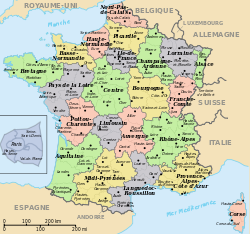
French regional cuisine is characterized by its extreme diversity and style. Traditionally, each region of France has its own distinctive cuisine.[11]
Paris and Île-de-France
[edit]Paris and Île-de-France are central regions where almost anything from the country is available, as alltrain linesmeet in the city. Over 9,000 restaurants exist in Paris and almost any cuisine can be obtained here. High-qualityMichelin Guide-rated restaurants proliferate here.[12]
Champagne, Lorraine, and Alsace
[edit]Game and ham are popular inChampagne,as well as the special sparkling wine simply known asChampagne.Fine fruit preserves are known fromLorraineas well as thequiche Lorraine.[13]As region of historically Allemanic German cultureAlsacehas retained Elements ofGerman cuisine,especially similar to those from the neighboringPalatinateandBadenregion, but has implemented French influences since France first took control of the region in the 17th century. As such,beersmade in the area are similar to the style of bordering Germany. Dishes likechoucroute(French forsauerkraut) are also popular.[12]: 55 Many "eaux de vie"(distilled alcohol from fruit) also called schnaps are from this region, due to a wide variety of local fruits (cherry, raspberry, pear, grapes) and especially prunes (mirabelle, plum).[9]:259,295[clarification needed]
-
AlsatianFlammekueche

Nord Pas-de-Calais, Picardy, Normandy, and Brittany
[edit]The coastline supplies manycrustaceans,sea bass,monkfishandherring.Normandyhas top-quality seafood, such asscallopsandsole,whileBrittanyhas a supply of lobster, crayfish andmussels.
Normandy is home to a large population of apple trees; apples are often used in dishes, as well asciderandCalvados.The northern areas of this region, especiallyNord,grow ample amounts of wheat, sugar beets andchicory.Thick stews are found often in these northern areas as well.
The produce of these northern regions is also considered some of the best in the country, including cauliflower and artichokes. Buckwheat grows widely in Brittany as well and is used in the region'sgalettes,calledjalet,which is where this dish originated.[12]: 93
-
Crème Chantilly,created at theChâteau de Chantilly.
Loire Valley and central France
[edit]High-quality fruits come from theLoire Valleyand central France, including cherries grown for the liqueurGuignoletandBelle Angevinepears. The strawberries and melons are also of high quality.
Fish are seen in the cuisine, often served with abeurre blancsauce, as well as wild game, lamb, calves,Charolais cattle,Gélinefowl, andgoat cheeses.
Young vegetables are used often, as are the specialty mushrooms of the region,champignons de Paris.Vinegars fromOrléansare a specialty ingredient used as well.[12]: 129, 132
Burgundy and Franche-Comté
[edit]BurgundyandFranche-Comtéare known for their wines.Pike,perch,river crabs, snails, game,redcurrants,blackcurrantsare from bothBurgundyandFranche-Comté.
Savory specialties accounted in theCuisine franc-comtoisefrom theFranche-Comtéregion arecroûte aux morilles,Poulet à la Comtoise,trout,smoked meats and cheeses such asMont d'Or,ComtéandMorbierwhich are best eaten hot or cold,coq au vin jauneand the special dessertgâteau de ménage.
Charolaisbeef,poultryfromBresse,sea snail,honey cake,ChaourceandÉpoissescheese are specialties of the local cuisine of Burgundy.Dijon mustardis also a specialty of Burgundy cuisine.Crème de cassisis a popular liquor made from blackcurrants. Oils are used in the cooking here, including nut oils andrapeseedoil.[12]: 153, 156, 166, 185
-
Escargots,with special tongs and fork
-
Beaujolaiswine
-
Gâteau de ménage
Auvergne-Rhône-Alpes
[edit]
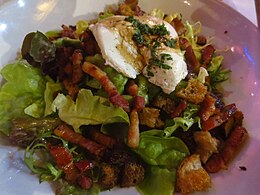


The area covers the old province ofDauphiné,once known as the "larder" of France,[dubious–discuss]that gave its name togratin dauphinois,[14]traditionally made in a large baking dish rubbed with garlic. Successive layers of potatoes, salt, pepper and milk are piled up to the top of the dish. It is then baked in the oven at low temperature for 2 hours.[15]
Fruit and young vegetables are popular in the cuisine from theRhône valley,as are wines likeHermitage AOC,Crozes-Hermitage AOCandCondrieu AOC.Walnutsand walnut products and oil fromNoix de Grenoble AOC,lowland cheeses, likeSt. Marcellin,St. Félicien andBleu du Vercors-Sassenage.
Poultry fromBresse,guinea fowl fromDrômeand fish from theDombes,a light yeast-based cake, called Pogne deRomansand the regional speciality,Raviole du Dauphiné,and there is theshort-crust"Suisse", aValencebiscuit speciality.
Lakes and mountain streams inRhône-Alpesare key to the cuisine as well.LyonandSavoysupply sausages while theAlpineregions supply their specialty cheeses likeBeaufort,Abondance,Reblochon,TommeandVacherin.[16][17][18][19]
Mères lyonnaisesare female cooks particular to this region who provide localgourmetestablishments.[20]Celebrated chefs from this region includeFernand Point,Paul Bocuse,theTroisgros brothersandAlain Chapel.[21]
TheChartreuse Mountainsare the source of the green and yellowdigestifliquorChartreuse,produced by the monks of theGrande Chartreuse.[12]: 197, 230
Since the 2014 administrative reform, the ancient area ofAuvergneis now part of theregion.One of its leading chefs isRegis Marcon.
-
Condrieuwine
-
Poulet de Bressechicken salad
-
Noix de Grenoble,unusual trilaterally symmetric walnut
-
Beaufort cheesesripening in a cellar
Poitou-Charentes and Limousin
[edit]Oysterscome from theOléron-Marennesbasin, whilemusselscome from theBay of Aiguillon.
High-quality produce comes from the region's hinterland, especially goat cheese. This region and in theVendéeis grazing ground forParthenaisecattle, while poultry is raised inChallans.
The region ofPoitou-Charentespurportedly produces the best butter and cream in France.Cognacis also made in the region along the riverCharente.
Limousinis home to theLimousin cattle,as well as sheep. The woodlands offer game and mushrooms. The southern area aroundBrivedraws its cooking influence fromPérigordandAuvergneto produce a robust cuisine.[12]: 237
Bordeaux, Périgord, Gascony, and Basque country
[edit]Bordeaux,a renowned French city, lends its name to a distinctive wine style celebrated worldwide.[22]Bordeaux, along with the largerAquitaineregion, ranks among the top three wine destinations globally, alongsideNapa ValleyandTuscany.Saint-Emilion,a UNESCO World Heritage village, is a key destination, drawing a multitude of wine tourists to the region.[22]
Bordeaux's diverse viticultural regions specialize in a range of grape varieties such as Merlot, Cabernet Franc, and increasingly Cabernet Sauvignon, each thriving in the picturesque landscapes of the area.[23]This variety contributes significantly to the region's rich viticultural diversity and the production of wines of strong quality.[23]
Building on this agricultural foundation, Bordeaux wine offers a rich history, varied terroir, and complex flavor profile, making it highly versatile for food pairing across various cuisines and occasions.[24]Traditional Bordeaux blends typically include the aforementionedCabernet Sauvignon,Merlot,andCabernet Franc,providing a spectrum of flavors and textures that complement a wide array of dishes.[24]
Lighter wines likeBordeaux Blancor a light-bodiedBordeaux Rougecan elegantly accompany seafood or poultry. The crisp acidity and citrus notes of Bordeaux Blanc complement delicate seafood dishes like grilled fish or shrimp cocktail, while the soft tannins of a light Bordeaux Rouge enhance the flavors of roasted chicken or turkey.[24]Moreover, Bordeaux Rouge wines pair beautifully with dishes like roasted lamb, duck breast, or vegetable stews. The wine's balanced fruitiness and moderate tannins complement the richness of the proteins without overpowering the palate.[24]
Meanwhile, more robust Bordeaux Rouge wines, particularly from renowned appellations likeSaint-Émilion,are perfect for richer, savory dishes such as grilled steak or braised beef, where their intense fruit flavors and firm tannins provide a balanced counterpoint to the umami-rich flavors.[24]Understanding this interplay of flavors allows diners to elevate their culinary experiences, creating memorable pairings with Bordeaux wines.[24]
The Pyrenees also has lamb, such as theAgneau de Pauillac,as well as sheep cheeses. Beef cattle in the region include theBlonde d'Aquitaine,Boeuf de Chalosse,Boeuf Gras de Bazas,andGaronnaise.
Free-range chicken, turkey, pigeon,capon,goose and duck prevail in the region as well.GasconyandPérigordcuisines includespâtés,terrines,confitsandmagrets.This is one of the regions notable for its production offoie gras,or fattened goose or duck liver.
The cuisine of the region is often heavy and farm-based.Armagnacis also from this region, as are prunes fromAgen.[12]: 259, 295
-
Black Périgordtruffle
Toulouse, Quercy, and Aveyron
[edit]Gers,a department of France, is within this region and has poultry, whileLa Montagne NoireandLacaunearea offer hams and dry sausages.
White corn is planted heavily in the area both for use in fattening ducks and geese for foie gras and for the production ofmillas,a cornmeal porridge.Haricot beansare also grown in this area, which are central to the dishcassoulet.
The finest sausage in France issaucisse de Toulouse,which also part ofcassouletofToulouse.TheCahorsarea produces a specialty "black wine"as well astrufflesand mushrooms.
This region also produces milk-fed lamb. Unpasteurizedewe's milk is used to produceRoquefortinAveyron,while inLaguioleis producing unpasteurized cow's milk cheese.Salerscattle produce milk for cheese, as well as beef and veal products.
The volcanic soils create flinty cheeses and superb lentils. Mineral waters are produced in high volume in this region as well.[12]: 313 Cabécou cheeseis fromRocamadour,a medieval settlement erected directly on a cliff, in the rich countryside ofCausses du Quercy.
This area is one of the region's oldest milk producers[verification needed];it has chalky soil, marked by history and human activity, and is favourable for the raising of goats.
-
Roquefortcheese
Roussillon, Languedoc, and Cévennes
[edit]Restaurants are popular in the area known asLe Midi.Oysters come from theÉtang de Thau,to be served in the restaurants ofBouzigues,Mèze,andSète.Mussels are commonly seen here in addition to fish specialties of Sète,bourride,tiellesandrouille de seiche.
In theLanguedocjambon cru,sometimes known asjambon de montagneis produced. High qualityRoquefortcomes from thebrebis(sheep) on theLarzacplateau.
TheLes Cévennesarea offers mushrooms, chestnuts, berries, honey, lamb, game, sausages,pâtésandgoat cheeses.Catalaninfluence can be seen in the cuisine here with dishes likebrandademade from a purée of driedcodwrapped inmangoldleaves. Snails are plentiful and are prepared in a specificCatalanstyle known as acargolade.Wild boarcan be found in the more mountainous regions of theMidi.[12]: 349, 360
Provence-Alpes-Côte d'Azur
[edit]TheProvenceandCôte d'Azurregion is rich in quality citrus, vegetables, fruits and herbs; the region is one of the largest suppliers of all these ingredients in France. The region also produces the largest amount of olives, and creates superb olive oil.Lavenderis used in many dishes found in Haute-Provence. Other important herbs in the cuisine includethyme,sage,rosemary,basil,savory,fennel,marjoram,tarragon,oregano,andbay leaf.[25]Honey is a prized ingredient in the region.
Seafoodis widely available throughout the coastal area and is heavily represented in the cuisine.Goat cheeses,air-dried sausages, lamb, beef, and chicken are popular here. Garlic and anchovies are used in many of the region's sauces, as inPoulet Provençal,which uses white wine, tomatoes, herbs, and sometimes anchovies, andPastisis found everywhere that alcohol is served.
The cuisine uses a large amount of vegetables for lighter preparations. Truffles are commonly seen in Provence during the winter.Thirteen dessertsin Provence are the traditional Christmas dessert,[26]e.g.quince cheese,biscuits, almonds,nougat,apple, andfougasse.
Rice is grown in theCamargue,which is the northernmost rice growing area in Europe, withCamargue red ricebeing a specialty.[12]: 387, 403, 404, 410, 416 Anibal Camous, a Marseillais who lived to be 104, maintained that it was by eating garlic daily that he kept his "youth" and brilliance. When his eighty-year-old son died, the father mourned: "I always told him he wouldn't live long, poor boy. He ate too little garlic!"
-
Vacqueyraswine
Corsica
[edit]Goats and sheep proliferate on the island ofCorsica,and lamb are used to prepare dishes such asstufato,ragoutsand roasts. Cheeses are also produced, withbrocciubeing the most popular.
Chestnuts,growing in the Castagniccia forest, are used to produce flour, which is used in turn to make bread, cakes andpolenta.The forest provides acorns used to feed the pigs andboarsthat provide much of the protein for the island's cuisine. Fresh fish and seafood are common.
The island's pork is used to make fine hams, sausage and other unique items includingcoppa(dried rib cut),lonzu(dried pork fillet),figatellu(smoked and dried liverwurst),salumu(a dried sausage),salcietta,Panzetta,bacon, andprisuttu(farmer's ham).
Clementines(which hold an AOC designation), lemons, nectarines and figs are grown there. Candiedcitronis used innougats,while and the aforementionedbrocciuand chestnuts are also used in desserts.
Corsica offers a variety of wines and fruit liqueurs, including Cap Corse, Patrimonio,Cédratine,Bonapartine,liqueur de myrte,vins de fruit,Rappu,andeau-de-viede châtaigne.[12]: 435, 441, 442
French Guiana
[edit]French Guianan cuisineorGuianan cuisineis a blend of the different cultures that have settled inFrench Guianaincluding European, Indian, Indigenous (Amerindian), Chinese, and Hmong influences.[27][28]Common dishes include fricassés, stews made ofawara broth(made from palm pulp), blaff (onions, garlic, celery and basil broth), pimentade (tomato sauce broth) or roast cougnade (grilled fish), and Colombos (meat-based stew and vegetables with curry).[29][28]There are markets inCayenneselling fresh and prepared foods among other items.[30]Some dishes from Metropolitan France are reimagined using local ingredients such as Gratin de Couac usingcassava rootin lieu of potato.[31]
-
Achards de légumes
-
Colombo de poulet
-
Fricassée de bœuf au riz créole
Réunion
[edit]The cuisine ofRéunionis aCreole cuisine(in French,Créole) with a mixture of cooking styles and ingredients. It is strongly influenced byMalagasy cuisine(fromMadagascar), as well as other cuisines fromEast Africa.It also incorporates elements of larger French,IndianandChinesecuisines, brought by French colonialization and Indian and Chinese immigrants respectively.[32][33]Notable dishes include samosas, bouchons, rougail, and various curries.[34]
-
Plat de la cuisine réunionaise
-
Somasa
-
Saladier de rougail
Martinique
[edit]Thecuisine of Martiniqueis aCreole cuisinewith a mix of French, indigenous, African, and Indian cooking styles using local ingredients such asbreadfruit,cassava,andchristophene.[35]Creole dishes rely heavily onseafood,includingcurriesandfritters.Crêperies,Brasseries, and restaurants featuring cuisine from various French regions can be found all over Martinique.[35]Notable local dishes include Accra a fish-based fritter, Boudin sausage, Fricassée de chatrou an occotpus stew, Colombo de Martinique a coconut-milk based curry, and Ti Punch a rum and cane juice based drink.[36]
Guadeloupe
[edit]The cuisine ofGuadeloupeincludes Caribbean, African, European and Indian influences. Notable dishes includes the fish fritter accra, a savory stuffed donut called bokit, and coconut-based desserts like custard and sorbet.[37]Notably. the spice blend "colombo" or "massalé" is a curry-like mix of pepper, saffron, coriander, cumin and garlic with the flavor profile included by Sri Lankan immigrants.[37][38]The island is also known for rums and includes nine distilleries producing traditional and agricultural rum.[38]
New Caledonia
[edit]The cuisine ofNew Caledoniaincludes local Kanak, Melanesian, and traditional French cooking styles.[39]A notable local dish is bougna which is a stew composed of starches, taros, sweet potatoes, poingo bananas, yams, and is accompanied by local meat and cooked in coconut milk.[40]Seafood is also common including fish and lobster.[41]Traditional French pastries, breads, and cheese may also be found especially in the capital ofNouméa.[39]
-
Bougna
-
Travail du coco par une femme Kanak
French Polynesia
[edit]Thecuisine of French Polynesiaincludes a significant array of fruits and vegetables especially sweet potato and coconut.[42]Due to the island nature of the region, seafood is also very common.[43]The "ahima’a",is a traditional Polynesian underground oven in which hot stones are placed inside to cook the ingredients.[43]Notable dishes includeFaraoa 'ipo,Poisson cruandRēti'a.
Mayotte
[edit]Thecuisine of Mayotteincludes influences from European France, Portugal, the Arab world, and India.[44]Common food includes rice as a daily staple mixed with root vegetables, plantains, fresh and dried fish, and milk from grated coconuts and meat. Notable dishes include Chahoula ya nadzi, rice boiled in water or coconut milk generally served for large meals and makarara a festive fried cake that is prepared into rolls of dough made of flour and coconut milk.[45][46]
-
Pilao
-
Romazava
Specialties by season
[edit]French cuisine varies according to the season. In summer, salads and fruit dishes are popular because they are refreshing and produce is inexpensive and abundant. Greengrocers prefer to sell their fruits and vegetables at lower prices if needed, rather than see them rot in the heat. At the end of summer, mushrooms become plentiful and appear in stews throughout France. The hunting season begins in September and runs through February. Game of all kinds is eaten, often in elaborate dishes that celebrate the success of the hunt. Shellfish are at their peak when winter turns to spring, and oysters appear in restaurants in large quantities.
With the advent of deep-freeze and the air-conditionedhypermarché,these seasonal variations are less marked than before, but they are still observed, in some cases due to legal restrictions.Crayfish,for example, have a short season and it is illegal to catch them out of season.[47]Moreover, they do not freeze well.
Foods and ingredients
[edit]French regional cuisines use locally grown vegetables, such aspomme de terre(potato),blé(wheat),haricots verts(a type of French green bean),carotte(carrot),poireau(leek),navet(turnip),aubergine(eggplant),courgette(zucchini), andéchalotte(shallot).
French regional cuisines use locally grown fungi, such astruffe(truffle),champignon de Paris(button mushroom),chanterelle ou girolle(chanterelle),pleurote (en huître)(oyster mushrooms), andcèpes(porcini).
Common fruits include oranges, tomatoes,tangerines,peaches,apricots,apples,pears,plums,cherries,strawberries,raspberries,redcurrants,blackberries,grapes,grapefruit,andblackcurrants.
Varieties of meat consumed includepoulet(chicken),pigeon(squab),canard(duck),oie(goose,the source offoie gras),bœuf(beef),veau(veal),porc(pork),agneau(lamb),mouton(mutton),caille(quail),cheval(horse),grenouille(frog), andescargot(snails). Commonly consumed fish and seafood includecod,canned sardines,fresh sardines,cannedtuna,fresh tuna,salmon,trout,mussels,herring,oysters,shrimpandcalamari.
Eggs often eaten as:omelettes,hard-boiled withmayonnaise,scrambledplain, scrambledhaute cuisinepreparation,œuf à la coque.
Herbs and seasonings vary by region, and includefleur de sel,herbes de Provence,olive,tarragon,rosemary,marjoram,lavender,thyme,fennel,andsage.
Fresh fruit and vegetables, as well as fish and meat, can be purchased either from supermarkets or specialty shops. Street markets are held on certain days in most localities; some towns have a more permanent covered market enclosing food shops, especially meat and fish retailers. These have better shelter than the periodic street markets.
-
Blé (Wheat)
Structure of meals
[edit]Breakfast
[edit]This sectionneeds additional citations forverification.(July 2020) |

Le petit déjeuner(breakfast) is traditionally a quick meal consisting oftartines(slices) of French bread with butter and honey or jam (sometimesbrioche), along withcafé au lait(also calledcafé crème), or black coffee, or tea[48]and rarely hot chicory. Children often drinkhot chocolatein bowls or cups along with their breakfasts.Croissants,pain aux raisinsorpain au chocolat(also namedchocolatinein the south-west of France) are mostly included as a weekend treat. Breakfast of some kind is always served in cafés opening early in the day.
There are also savoury dishes for breakfast. An example isle petit déjeuner gauloisorpetit déjeuner fermierwith the famous long narrow bread slices topped with soft white cheese or boiled ham, calledmouillettes,[49]which is dipped in a soft-boiled egg and some fruit juice and hot drink.
Another variation calledle petit déjeuner chasseur,meant to be very hearty, is served withpâtéand othercharcuterieproducts. A more classy version is calledle petit déjeuner du voyageur,where delicatessens serve gizzard, bacon, salmon, omelet, orcroque monsieur,with or without soft-boiled egg and always with the traditional coffee/tea/chocolate along fruits or fruit juice. When the egg is cooked sunny-side over thecroque-monsieur,it is called acroque-madame.
InGerminaland other novels,Émile Zolaalso mentioned thebriquet:two long bread slices stuffed with butter, cheese and or ham. It can be eaten as a standing/walking breakfast, or meant as a "second" one before lunch.
In the movieBienvenue chez les Ch'tis,Philippe Abrams (Kad Merad) and Antoine Bailleul (Dany Boon) share together countless breakfasts consisting oftartines de Maroilles(a strong cheese) along with their hot chicory.
Lunch
[edit]Le déjeuner(lunch) is a two-hour mid-day meal or a one-hour lunch break[verification needed].In some smaller towns and in the south of France, the two-hour lunch may still be customary[verification needed].Sunday lunches are often longer and are taken with the family.[50]Restaurants normally open for lunch at noon and close at 2:30 pm. Some restaurants are closed on Monday during lunch hours.[51]
In largecities,a majority of working people andstudentseat their lunch at a corporate or school cafeteria, which normally serves complete meals as described above; it is not usual for students to bring their own lunch to eat. For companies that do not operate a cafeteria, it is mandatory for employees to be given lunch vouchers as part of their employee benefits. These can be used in most restaurants, supermarkets andtraiteurs;however, workers having lunch in this way typically do not eat all three courses of a traditional lunch due to price and time constraints. In smaller cities and towns, some working people leave their workplaces to return home for lunch. An alternative, especially amongblue-collar workers,is eating sandwiches followed by a dessert; both dishes can be found ready-made at bakeries and supermarkets at budget prices.
Dinner
[edit]Le dîner(dinner) often consists of threecourses,hors d'œuvreorentrée(appetizers or introductory course, sometimes soup),plat principal(main course), and a cheese course or dessert, sometimes with a salad offered before the cheese or dessert. Yogurt may replace the cheese course, while a simple dessert would be fresh fruit. The meal is often accompanied by bread,wineandmineral water.Most of the time the bread would be abaguettewhich is very common in France and is made almost every day. Main meat courses are often served with vegetables, along with potatoes, rice or pasta.[50]: 82 Restaurants often open at 7:30 pm for dinner, and stop taking orders between the hours of 10:00 pm and 11:00 pm. Some restaurants close for dinner on Sundays.[51]: 342
Beverages and drinks
[edit]In French cuisine, beverages that precede a meal are calledapéritifs(literally: "that opens the appetite" ), and can be served withamuse-gueules(literally: "mouth amuser" ). Those that end it are calleddigestifs.During the meal, plates are served with water, wine or sometimes beer (choucrouteand beer, for example).
- Apéritifs
Theapéritifvaries from region to region:Pastisis popular in the south of France,Crémant d'Alsacein the eastern region.Champagnecan also be served.Kir,also calledblanc-cassis,is a common and popularapéritif-cocktail made with a measure ofcrème de cassis(blackcurrant liqueur) topped up withwhite wine.The phrasekir royalis used when white wine is replaced with a Champagne wine. A simple glass of red wine, such asBeaujolais nouveau,can also be presented as anapéritif,accompanied byamuse-bouches.Someapéritifscan befortified wineswith added herbs, such ascinchona,gentianandvermouth.Trade names that sell well includeSuze(the classic gentiane),Byrrh,Dubonnet,andNoilly Prat.Beer can also be anapéritif.Other drinks are fruit juices or syrups for children.
- Digestifs
Digestifsare traditionally stronger, and includeCognac,Armagnac,Calvados,eau de vieand fruit alcohols.
Christmas
[edit]A typicalFrench Christmasdish is turkey or capon, with chestnuts. Other common dishes are smoked salmon, oysters, caviar andfoie gras.TheYule log(bûche de Noël) is a very French tradition during Christmas. Chocolate and cakes also occupy a prominent place for Christmas in France. This cuisine is normally accompanied by Champagne. Tradition says that thirteen desserts complete the Christmas meal in reference to the twelve apostles and Christ.[52][53][54][55]

Food establishments
[edit]
History
[edit]The modern restaurant has its origins in French culture. Prior to the late 18th century, diners who wished to "dine out" would visit their localguildmember's kitchen and have their meal prepared for them. However, guild members were limited to producing whatever their guild registry delegated to them.[56]: 8–10 These guild members offered food in their own homes to steady clientele that appeared day-to-day but at set times. The guest would be offered the mealtable d'hôte,which is a meal offered at a set price with very little choice of dishes, sometimes none at all.[56]: 30–31
The first steps toward the modern restaurant were locations that offered "restorative"bouillons,orrestaurants—these words being the origin of the name "restaurant". This step took place during the 1760s–1770s. These locations were open at all times of the day, featuring ornate tableware and reasonable prices. These locations were meant more as meal replacements for those who had "lost their appetites and suffered from jaded palates and weak chests."[56]: 34–35
In 1782Antoine Beauvilliers,pastry chefto the futureLouis XVIII,opened one of the most popular restaurants of the time—theGrande Taverne de Londres—in the arcades of thePalais-Royal.Other restaurants were opened by chefs of the time who were leaving the failingmonarchy of France,in the period leading up to theFrench Revolution.It was these restaurants that expanded upon the limited menus of decades prior, and led to the full restaurants that were completely legalized with the advent of the French Revolution and the abolition of the guilds. This and the substantial discretionary income of theFrench Directory'snouveau richehelped keep these new restaurants in business.[56]: 140–144



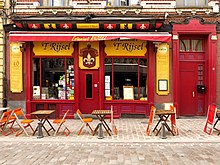
| English | French | Description |
|---|---|---|
| Restaurant | More than 5,000 in Paris alone, with varying levels of prices and menus. Open at certain times of the day, and normally closed one day of the week. Patrons select items from a printedmenu.Some offer regional menus, while others offer a modern styled menu. Waiters and waitresses are trained and knowledgeable professionals. By law, aprix fixemenu must be offered, although high-class restaurants may try to conceal the fact. Few French restaurants cater to vegetarians. TheGuide Michelinrates many of the better restaurants in this category.[12]: 30 | |
| Bistro(t) | Often smaller than a restaurant and many times using chalk board or verbal menus. Wait staff may well be untrained. Many feature a regional cuisine. Notable dishes includecoq au vin,pot-au-feu,confit de canard,calves' liver andentrecôte.[12]: 30 | |
| Bistrot à Vin | Similar tocabaretsortavernesof the past in France. Some offer inexpensive alcoholic drinks, while others take pride in offering a full range of vintageAOCwines. The foods in some are simple, including sausages, ham and cheese, while others offer dishes similar to what can be found in a bistro.[12]: 30 | |
| Bouchon | Found inLyon,they produce traditional Lyonnaise cuisine, such as sausages, duckpâtéor roast pork. The dishes can be quite fatty, and heavily oriented around meat. There are about twenty officially certified traditional bouchons, but a larger number of establishments describing themselves using the term.[57] | |
| Brewery | Brasserie | These establishments were created in the 1870s by refugees fromAlsace-Lorraine.These establishments serve beer, but most serve wines from Alsace such asRiesling,Sylvaner,andGewürztraminer.The most popular dishes arechoucrouteandseafooddishes.[12]: 30 In general, a brasserie is open all day every day, offering the same menu.[58] |
| Café | Primarily locations for coffee and alcoholic drinks. Additional tables and chairs are usually set outside, and prices are usually higher for service at these tables. The limited foods sometimes offered includecroque-monsieur,salads,moules-frites(musselsandpommes frites) when in season.Cafésoften open early in the morning and shut down around nine at night.[12]: 30 | |
| Salon de Thé | These locations are more similar to cafés in the rest of the world. These tearooms often offer a selection of cakes and do not offer alcoholic drinks. Many offer simple snacks, salads, and sandwiches. Teas, hot chocolate, andchocolat à l'ancienne(a popular chocolate drink) are offered as well. These locations often open just prior to noon for lunch and then close late afternoon.[12]: 30 | |
| Bar | Based on the American style, many were built at the beginning of the 20th century (particularly around World War I, when young American expatriates were quite common in France, particularly Paris). These locations serve cocktails, whiskey,pastisand other alcoholic drinks.[12]: 30 | |
| Estaminet | Typical of theNord-Pas-de-Calaisregion, these small bars/restaurants used to be a central place for farmers, mine or textile workers to meet and socialize, sometimes the bars would be in a grocery store.[59]Customers could order basic regional dishes, play boules, or use the bar as a meeting place for clubs.[60]These estaminets almost disappeared, but are now considered a part of Nord-Pas-de-Calais history, and therefore preserved and promoted. | |
Restaurant staff
[edit]Larger restaurants and hotels in France employ extensive staff and are commonly referred to as either thekitchen brigadefor the kitchen staff ordining room brigadesystem for the dining room staff. This system was created byGeorges Auguste Escoffier.This structured team system delegates responsibilities to different individuals who specialize in certain tasks. The following is a list of positions held both in the kitchen and dining rooms brigades in France:[12]: 32
| Section | French | English | Duty |
|---|---|---|---|
| Kitchen brigade | Chef de cuisine | Head chef | Responsible for overall management of kitchen. They supervise staff, and create menus and new recipes with the assistance of the restaurant manager, make purchases of raw food items, train apprentices and maintain a sanitary and hygienic environment for the preparation of food.[12]: 32 |
| Sous-chef de cuisine | Deputy Head chef | Receives orders directly from thechef de cuisinefor the management of the kitchen and often represents thechef de cuisinewhen he or she is not present.[12]: 32 | |
| Chef de partie | Senior chef | Responsible for managing a given station in the kitchen where they specialize in preparing particular dishes. Those that work in a lesser station are referred to as ademi-chef.[12]: 32 | |
| Cuisinier | Cook | This position is an independent one where they usually prepare specific dishes in a station. They may be referred to as acuisinier de partie.[12]: 32 | |
| Commis | Junior cook | Also works in a specific station, but reports directly to thechef de partieand takes care of the tools for the station.[12]: 32 | |
| Apprenti(e) | Apprentice | Many times they are students gaining theoretical and practical training in school and work experience in the kitchen. They perform preparatory or cleaning work.[12]: 30 | |
| Plongeur | Dishwasher | Cleans dishes and utensils and may be entrusted with basic preparatory jobs.[12]: 32 | |
| Marmiton | Pot and pan washer | In larger restaurants, takes care of all the pots and pans instead of theplongeur.[12]: 33 | |
| Saucier | Saucemaker/sauté cook | Preparessauces,warmhors d'œuvres,completes meat dishes and in smaller restaurants may work on fish dishes and prepare sautéed items. This is one of the most respected positions in the kitchen brigade.[12]: 32 | |
| Rôtisseur | Roast cook | Manages a team of cooks that roasts, broils and deep fries dishes.[12]: 32 | |
| Grillardin | Grill cook | In larger kitchens this person prepares the grilled foods instead of therôtisseur.[61]: 8 | |
| Friturier | Fry cook | In larger kitchens this person prepares fried foods instead of therôtisseur.[61] | |
| Poissonnier | Fish cook | Prepares fish and seafood dishes.[12]: 33 | |
| Entremetier | Entrée preparer | Prepares soups and other dishes not involving meat or fish, including vegetable dishes and egg dishes.[12]: 32 | |
| Potager | Soup cook | In larger kitchens, this person reports to theentremetierand prepares the soups.[61] | |
| Legumier | Vegetable cook | In larger kitchen this person also reports to theentremetierand prepares the vegetable dishes.[61] | |
| Garde manger | Pantry supervisor | Responsible for preparation of coldhors d'œuvres,prepares salads, organizes large buffet displays and preparescharcuterieitems.[12]: 30 | |
| Tournant | Spare hand/ roundsperson | Moves throughout kitchen assisting other positions in kitchen. | |
| Pâtissier | Pastry cook | Prepares desserts and other meal end sweets, and in locations without aboulangeralso prepares breads and other baked items. They may also prepare pasta for the restaurant.[12]: 33 | |
| Confiseur | Prepares candies andpetit foursin larger restaurants instead of thepâtissier.[61] | ||
| Glacier | Prepares frozen and cold desserts in larger restaurants instead of thepâtissier.[61] | ||
| Décorateur | Prepares show pieces and specialty cakes in larger restaurants instead of thepâtissier.[61]: 8–9 | ||
| Boulanger | Baker | Prepares bread, cakes and breakfast pastries in larger restaurants instead of thepâtissier.[12]: 33 | |
| Boucher | Butcher | Butchers meats, poultry and sometimes fish. May also be in charge of breading meat and fish items.[61] | |
| Aboyeur | Announcer/ expediter | Takes orders from dining room and distributes them to the various stations. This position may also be performed by thesous-chef de partie.[61] | |
| Communard | Prepares the meal served to the restaurant staff.[61] | ||
| Garçon de cuisine | Performs preparatory and auxiliary work for support in larger restaurants.[12]: 33 | ||
| Dining room brigade | Directeur de la restauration | General manager | Oversees economic and administrative duties for all food-related business in large hotels or similar facilities including multiple restaurants, bars, catering and other events.[12]: 33 |
| Directeur de restaurant | Restaurant manager | Responsible for the operation of the restaurant dining room, which includes managing, training, hiring and firing staff, and economic duties of such matters. In larger establishments there may be an assistant to this position who would replace this person in their absence.[12]: 33 | |
| Maître d'hôtel | Welcomes guests, and seats them at tables. They also supervise the service staff. Commonly deals with complaints and verifies patrons' bills.[12]: 33 | ||
| Chef de salle | Commonly in charge of service for the full dining room in larger establishments; this position can be combined into themaître d'hotelposition.[61] | ||
| Chef de rang | The dining room is separated into sections calledrangs.Eachrangis supervised by this person to coordinate service with the kitchen.[12]: 33 | ||
| Demi-chef de rang | Back server | Clears plates between courses if there is nocommis débarrasseur,fills water glasses and assists thechef de rang.[61] | |
| commis de rang | |||
| Commis débarrasseur | Clears plates between courses and the table at the end of the meal.[12]: 33 | ||
| Commis de suite | In larger establishments, this person brings the different courses from the kitchen to the table.[12]: 33 | ||
| Chef d'étage | Captain | Explains the menu to the guest and answers any questions. This person often performs the tableside food preparations. This position may be combined with thechef de rangin smaller establishments.[61] | |
| Chef de vin | Wine server | Manages wine cellar by purchasing and organizing as well as preparing the wine list. Also advises the guests on wine choices and serves the wine.[12]: 33 | |
| Sommelier | |||
| chef sommelier | In larger establishments, this person will manage a team of sommeliers.[12]: 33 | ||
| chef caviste | |||
| Serveur de restaurant | Server | This position found in smaller establishments performs the multiple duties of various positions in the larger restaurants in the service of food and drink to the guests.[12]: 33 | |
| Responsable de bar | Bar manager | Manages the bar in a restaurant, which includes ordering and creating drink menus; they also oversee the hiring, training and firing of barmen. Also manages multiple bars in a hotel or other similar establishment.[12]: 33 | |
| Chef de bar | |||
| Barman | Bartender | Serves alcoholic drinks to guests.[12]: 33 | |
| Dame du vestiaire | Coat room attendant who receives and returns guests' coats and hats.[12]: 33 | ||
| Voituriers | Valet | Parks guests' cars and retrieves them when the guests leave.[12]: 33 | |
See also
[edit]- Cuisine of Quebec
- Acadian cuisine
- Cajun cuisine
- French Americans
- French Canadians
- French paradox
- Larousse Gastronomique
- Le Répertoire de la Cuisine
- List of French cheeses
- List of French desserts
- List of French dishes
- List of French restaurants
- List of French soups and stews
- List of restaurants in Paris
References
[edit]- ^Miller, Norman (October 2014)."The ABCs of AOC: France's Most Prized Produce".FrenchEntree Magazine.Archivedfrom the original on 14 May 2021.Retrieved13 May2021.
- ^"Bon appétit: Your meal is certified by the UN".Archived20 November 2010 at theWayback MachineDallas Morning News.
- ^UNESCO (16 November 2010)."Celebrations, healing techniques, crafts and culinary arts added to the Representative List of the Intangible Cultural Heritage".UNESCO.Archivedfrom the original on 27 January 2011.Retrieved4 June2012.
- ^abcdefghijklmWheaton, Barbara Ketcham (1996).Savoring the Past: The French Kitchen and Table from 1300 to 1789.New York: First Touchstone.ISBN978-0-684-81857-3.
- ^abBrace, Richard Munthe (1946). "The Problem of Bread and the French Revolution at Bordeaux".The American Historical Review.51(4): 649–667.doi:10.2307/1843902.JSTOR1843902.
- ^abcdefghiMennell, Stephen (1996).All Manners of Food: eating and taste in England and France from the Middle Ages to the present, 2nd ed.Chicago: University of Illinois Press.ISBN978-0-252-06490-6.
- ^Escoffier, Georges Auguste (2002).Escoffier: The Complete Guide to the Art of Modern Cookery.New York: John Wiley and Sons. pp. Foreword.ISBN978-0-471-29016-2.
- ^Joyeuse encyclopédie anecdotique de la gastronomie,Michel Ferracci-Porriand Maryline Paoli, Preface by Christian Millau, Ed. Normant 2012, FranceISBN978-2-915685-55-8
- ^Hewitt, Nicholas (2003).The Cambridge Companion to Modern French Culture.Cambridge: The Cambridge University Press. pp. 109–110.ISBN978-0-521-79465-7.
- ^Terrio, Susan (2016). "Visions of Excess: Crafting and Consuming Good Chocolate in France and the United States". In Wilkinson-Weber, Clare M; DeNicola, Alicia Ory (eds.).Critical Craft: Technology, Globalization, and Capitalism.London and New York:Routledge.ISBN978-1-4725-9485-3.
- ^"French Country Cooking."Archived18 June 2011 at theWayback MachineFrench-country-decor-guideArchived3 July 2011 at theWayback Machine.Accessed July 2011.
- ^abcdefghijklmnopqrstuvwxyzaaabacadaeafagahaiajakalamanaoapaqarasatauavawDominé, André (2004).Culinaria France.Cologne: Könemann Verlagsgesellschaft mbh.ISBN978-3-8331-1129-7.
- ^"25 Authentic French Foods Everyone Must Try!".Travel Food Atlas.29 March 2020.Archivedfrom the original on 5 March 2021.Retrieved29 December2020.
- ^"Bibliothèque dauphinoise: La cuisine dauphinoise, René Fonvieille".bibliotheque-dauphinoise.Archivedfrom the original on 24 December 2017.Retrieved25 November2022.
- ^Arces, Amicie d'; Cheylard, A. Vallentin du (1997).Cuisine du Dauphiné: Drôme, Hautes-Alpes, I sắc re: de A à Z(in French). La Fontaine de Siloë.ISBN978-2-86253-216-5.
- ^"Lyon Sausage -: Whats on the menu?".menus.nypl.org.Retrieved10 June2021.
- ^"Véritable Saucisson de Lyon".Spécialités Lyonnaises(in French). Archived fromthe originalon 26 February 2018.Retrieved10 June2021.
- ^"The culinary heritage of the French mountains".uk.france.fr.Retrieved10 June2021.[permanent dead link]
- ^"10 fromages de montagne incontournables".hardloop.fr(in French).Retrieved10 June2021.
- ^Maier, Thomas, A. (2012).Hospitality Leadership Lessons in French Gastronomy: The Story of Guy and Franck Savoy.Authorhouse.ISBN9781468541083.p.19.https://books.google /books?id=MTts8MF4CRwC&dq=Lyon+gastronomy&pg=PA19Archived14 December 2023 at theWayback Machineretrieved 12-23-2017.
- ^Buford, Bill. (2011). "Why Lyon is the Food Capital of the World".The Guardian,13 February 2011.https:// theguardian /travel/2011/feb/13/bill-buford-lyon-food-capitalArchived21 January 2018 at theWayback Machineretrieved 12-23-2017
- ^abBouzdine-Chameeva, Tatiana; Faugère, Christophe (January 2016)."Wine tourism in Bordeaux".ResearchGate.
- ^abAsher, Gerald (2012).A Carafe of Red.California: Berkeley, CA: University of California Press. pp. 37–43.ISBN9786613369703.
- ^abcdefGagić, Snježana, and Milan Ivkov. "Food and Wine pairing-six course menu example."Hotelplan 2013, Contemporary trends in the hospitality industry, Belgrade, Serbia, 28th-29th November, pp. 451-462. ResearchGate.
- ^"Nice Cooking".La Cuisine Niçoise. Archived fromthe originalon 11 October 2017.Retrieved29 December2015.
- ^"Christmas traditions".Provenceweb.fr. Archived fromthe originalon 4 February 2012.Retrieved4 June2012.
- ^"A historical and cultural melting pot in French Guiana".france.fr.Archived fromthe originalon 24 February 2024.Retrieved24 February2024.
- ^ab"Sun-drenched flavours of French Guiana".france.fr.Retrieved24 February2024.
- ^"A taste of French Guiana's culinary specialties".france.fr.Retrieved24 February2024.
- ^The cosmopolitan and spicy cuisine of French Guiana | WIDE,15 July 2022,retrieved24 February2024
- ^Martin, Rick (19 August 2022)."French Guiana Food: French Cuisine in the Heart of South America".Latin Post.
- ^"Gastronomy".Île de la Réunion Tourisme.Archivedfrom the original on 26 February 2023.Retrieved26 February2023.
- ^rund3v."The dishes and dishes of Reunion".Reunion Island.Archivedfrom the original on 26 February 2023.Retrieved26 February2023.
{{cite web}}:CS1 maint: numeric names: authors list (link) - ^"Discover the cuisine of Reunion Island".france.fr.Archivedfrom the original on 26 February 2023.Retrieved26 February2023.
- ^ab"Gastronomy of Martinique".AZ Martinique.Archivedfrom the original on 26 February 2023.Retrieved26 February2023.
- ^Rabikowska, Suzy (30 March 2015)."Top 10 Martinican Dishes You Just Have to Try".Culture Trip.Archivedfrom the original on 16 March 2023.Retrieved26 February2023.
- ^ab"Gastronomy Of Guadeloupe Island".Alliance Française de San Francisco.Archivedfrom the original on 26 February 2023.Retrieved26 February2023.
- ^ab"Région Guadeloupe-Guadeloupe, a land of cultures and flavours".regionguadeloupe.fr.Archivedfrom the original on 26 February 2023.Retrieved26 February2023.
- ^ab"Culinary Postcard: Noumea, New Caledonia".Food.13 October 2022.Archivedfrom the original on 26 February 2023.Retrieved26 February2023.
- ^"New Caledonia - Kanak cooking".newcaledonia.travel.Archivedfrom the original on 28 March 2023.Retrieved26 February2023.
- ^"New Caledonia, a breeding ground of flavors - Elle & Vire Professionnel".Elle & Vire.Archivedfrom the original on 26 February 2023.Retrieved26 February2023.
- ^"Tahitian Food | French Polynesian Food | Tahitian Food Specialties".Tahiti Tourisme.Archivedfrom the original on 2 March 2023.Retrieved2 March2023.
- ^ab"Food in French Polynesia".YESTAHITI.Archivedfrom the original on 2 March 2023.Retrieved2 March2023.
- ^"What's Eaten Where: Mayotte | Cyprus Mail".cyprus-mail /.19 March 2021.Archivedfrom the original on 2 March 2023.Retrieved2 March2023.
- ^Le Petit Futé."MAYOTTE, Cuisine locale, guide touristique Petit Futé".petitfute(in French).Archivedfrom the original on 3 November 2020.Retrieved5 October2020.
- ^"Discovery Mayotte: Gastronomy".petitfute.co.uk.Archivedfrom the original on 2 March 2023.Retrieved2 March2023.
- ^Imported crayfish are unrestricted, and many arrive from Pakistan.
- ^Larousse Gastronomique.New York: Clarkson Potter. 2009. p. 780.ISBN978-0-307-46491-0.
- ^Larousse, Éditions."Définitions: mouillette - Dictionnaire de français Larousse".larousse.fr.Archivedfrom the original on 11 August 2017.Retrieved6 July2017.
- ^abSteele, Ross (2001).The French Way, 2nd ed.New York: McGraw-Hill.
- ^abFodor's (2006).See It. France. 2nd ed.New York: Fodor's Travel Publications.
- ^"10 traditions de Noël françaises - Cheznoscousins".30 December 2014. Archived fromthe originalon 9 October 2016.Retrieved6 July2017.
- ^"Noel dans le monde".Archived fromthe originalon 9 October 2016.Retrieved6 October2016.
- ^[1][dead link]
- ^"Les Fetes de Noel en France".referat.clopotel.ro.Archivedfrom the original on 11 October 2017.Retrieved6 July2017.
- ^abcdSpang, Rebecca L. (2001).The Invention of the Restaurant, 2nd Ed.Harvard University Press.ISBN978-0-674-00685-0.
- ^Boudou, Evelyne; Jean-Marc Boudou (2003).Les bonnes recettes des bouchons lyonnais.Seyssinet: Libris.ISBN978-2-84799-002-7.
- ^Ribaut, Jean-Claude (8 February 2007).Le Monde."Les brasseries ont toujours l'avantage d'offrir un service continu tout au long de la journée, d'accueillir les clients après le spectacle et d'être ouvertes sept jours sur sept, quand les restaurants ferment deux jours et demi par semaine."
"Brasseries have the advantage of offering uninterrupted service all day, seven days a week, and of being open for the after-theatre crowd, whereas restaurants are closed two and a half days of the week." - ^"Les Estaminets - Taverns".leershistorique.Archived fromthe originalon 3 March 2016.Retrieved6 July2017.
- ^Wytteman, JP, ed. (1988).Le Nord de la préhistoire à nos jours(in French). Bordessoules.p. 260.
- ^abcdefghijklmThe Culinary Institute of America(2006).The Professional Chef(8th ed.).Hoboken, New Jersey:John Wiley & Sons.ISBN978-0-7645-5734-7.
Further reading
[edit]- Patrick Rambourg,Histoire de la cuisine et de la gastronomie françaises,Paris, Ed. Perrin (coll. tempus n° 359), 2010, 381 pages.ISBN978-2-262-03318-7
- Bryan Newman, "Behind the French Menu",
External links
[edit]- France stages first-ever Gastronomy DayRadio France Internationale in English





















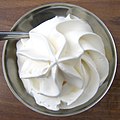


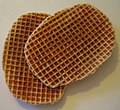
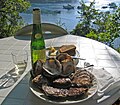








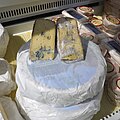



![Suisse de Valence biscuit [fr]](https://upload.wikimedia.org/wikipedia/commons/thumb/3/32/Suisse_biscuit.JPG/75px-Suisse_biscuit.JPG)











































